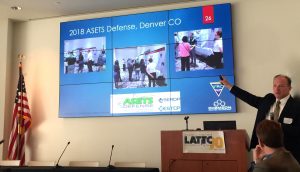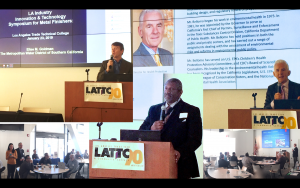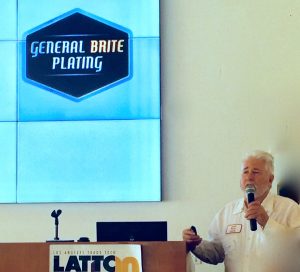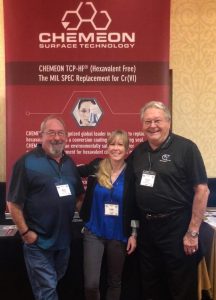2019 Florida Finishers Expo
 Los Angeles Metal Finishing Symposium
Los Angeles Metal Finishing Symposium
 CHEMEON® Surface Technology VP Technology,Dr. Sjon Westre
CHEMEON® Surface Technology VP Technology,Dr. Sjon Westre, delivered a Keynote presentation
“Hexavalent Chrome Alternatives”at the
Metal Finishing Symposium in Los Angeles on January 23rd. CHEMEON TCP-HF (Hexavalent Free) Suite of MIL-SPEC and Military grade chemistries meet or exceed and comply with MIL-DTL-81706. MIL-DTL-5541 Type II. MIL-C-5541 Class 1A and Class 3, ROHS. REACH. WEEE. ELV. OSHA, ASTM B921. CHEMEON TCP-HF, CHEMEON TCP HF- EPA (Extra Protection Additive) and CHEMEON TCP-HF SP (Spray) can be found on the Qualified Products List (QPL)

Keynote delivered by Dr. Sjon Westre, Vice President CHEMEON Surface Technology ”Hexavalent Chrome Alternatives” delivered to attendees of the Metal Finishing Symposium in Los Angeles, California.

Metal Finishing Symposium key players and exhibitor: (from left) Jennifer Kong P.E., Industrial Waste Management, L.A. Sanitation, Jane Williams, Executive Director CCAT, Mandi Bane PhD, Staff Analyst, Toxic Epidemiology Department, LA County Dept. of Public Health.
This collaborative effort to create a Metal Finishing Symposium between community action, industry and government was organized by the City of Los Angeles, LA Industry, County of Los Angeles, Public Health, LA City Sanitation/Environment, and the County of Los Angeles in conjunction with the Jane Williams and the California Communities Against Toxics (CCAT) and Wesley Turnbow of EME Plating on behalf of the Metal Finishing Association of Southern California (MFASC). CHEMEON is a proud member of both MFASC and Metal Finishers of Northern California (MFANC). LA Industry is a collaborative network of Los Angeles based businesses and resource agencies. Their goal is to achieve a cycle of sustainable practices that will benefit our environment, economy, and community.
EME Plating Owner/President Wesley Turnbow welcomed the audience and introduced opening remarks from Angelo Bellomo, Deputy Director for Health Protection, LA County Public Health (LACPH), and Michael Simpson, Industrial Waste Management Division Manager Los Angeles Sanitation/Environment.

Symposium welcome by Wesley Turnbow EME Plating/MFASC (upper left) and opening remarks by Michael Simpson, Industrial Waste Management Division Manager, LA County Public Health (LAPC) (center) and Angelo Bellomo, Deputy Director for Health Protection, LAPC. (far right)
EME Plating Owner/President Wesley Turnbow welcomed the audience and introduced opening remarks from Angelo Bellomo, Deputy Director for Health Protection, LA County Public Health (LACPH), and Michael Simpson, Industrial Waste Management Division Manager Los Angeles Sanitation/Environment.
Keynotes also included:
Alan Olick, Owner of General Brite Plating presented "Trivalent Chromium & Waste Reclamation"

“Trivalent Chromium and Waste Reclamation” Keynote presented by Alan Olick, President/Owner General Brite Dip
Justin Guzman, President AirCraft X-Ray presented “Technologically Advanced Wastewater Treatment.”

“Technologically Advanced Wastewater Treatment” Keynote Presenter Justin Guzman, President Aircraft X-Ray
Panels included:
 New Technologies in Metal Finishing
New Technologies in Metal Finishingpanel moderated by Wesley Turbow, past President MFASC and President/Owner of EME Plating. Panel included (from Left) Justin Guzman, President of Aircraft X-Ray, Alan Olick, Owner/President of General Brite Plating, Dr. Sjon Westre , Vice President Technology, CHEMEON Surface Technology. (Standing) Scott Peterson, President of Workflo by Beyond Relations.

The Panel “Water and Incentives” Water and Incentives which was led by Executive Director of CCAT and Environmental Justice Advocate Jane Williams, panelists included Victor Garcia, LA Department of Water and Power and Elise Goldman, Metropolitan Water District.
Water and Incentives was led by Executive Director of CCAT and Environmental Justice Advocate Jane Williams. Panelists included Victor Garcia, LA Department of Water and Power, and Elis Goldman, Metropolitan Water District.

California Metal Finishing Symposium 2019 attendees included (from left) Wesley Turnbow, Symposium Master of Ceremonies, Owner/President EME Plating and past President of the Metal Finishing Association of Southern California (MFASC), Dr. Sjon Westre, VP Technology, CHEMEON Surface Technology, Bryan Leiker, Executive Director Metal Finishing Association of California (MFACA), Dan Zinman, Miles Chemical
Request a copy of the CHEMEON keynote and learn more about MIL-SPEC CHEMEON TCP-HF
®(Hexavalent Free) and Military Grade “Hexavalent Chrome Alternatives.”Contact Shay Davis, Chemist, Business Development Manager,
sdavis@chemeon.comor call 775-782-8324.
2019 Florida Finishers Expo

CHEMEON Sponsors The Florida Finishing Conference/Expo 2019

(from left) CHEMEON on Display at the 9th Annual Florida Finishers Expo (from left) Mike Flanigan, Electrolab & Florida Finishers Corporation (FFC), Shay Davis, CHEMEON Chemist & Business Development Manager, and Clay Mueller, Plating Specialists Inc. and FFC Executive Member













